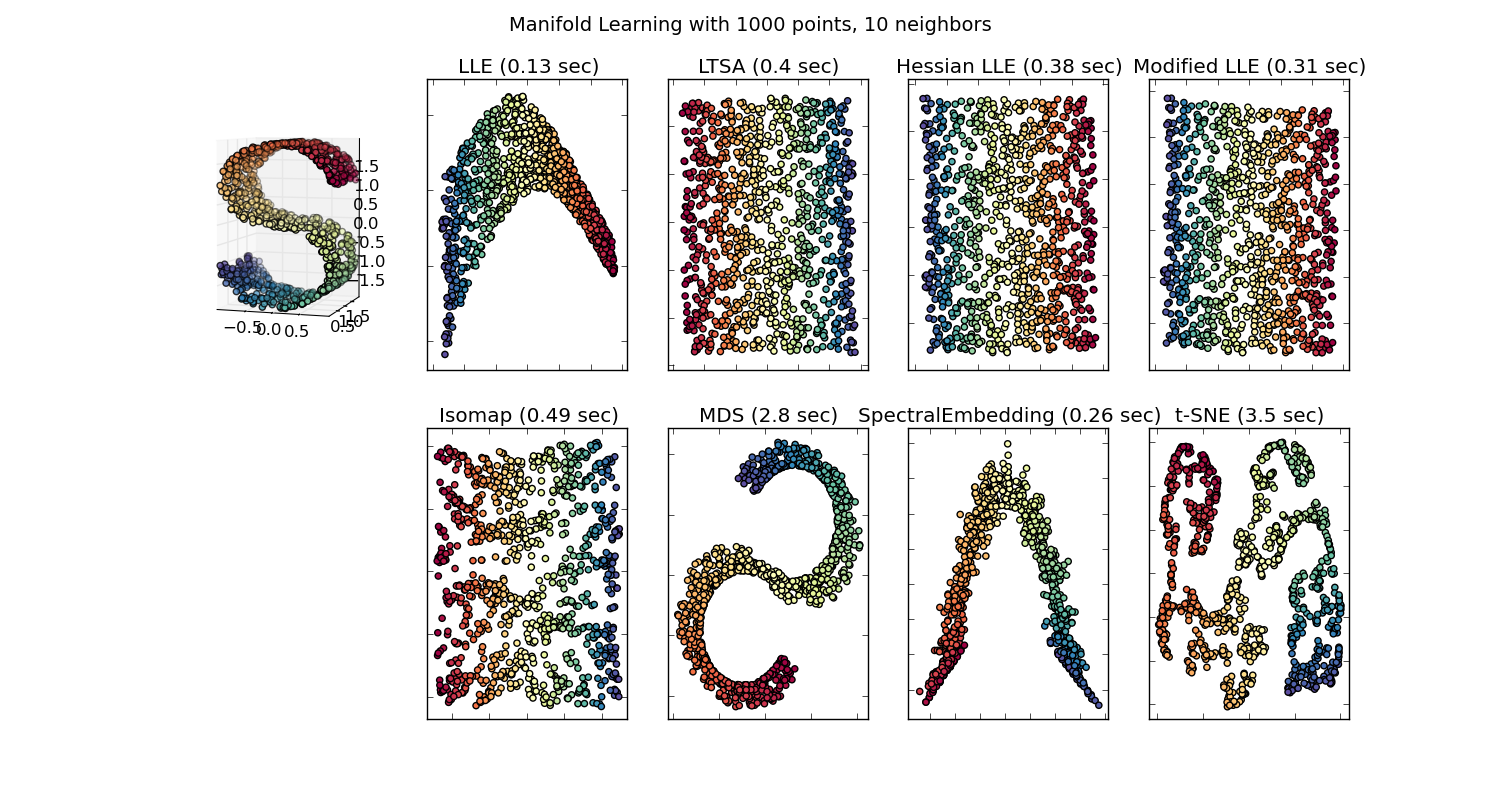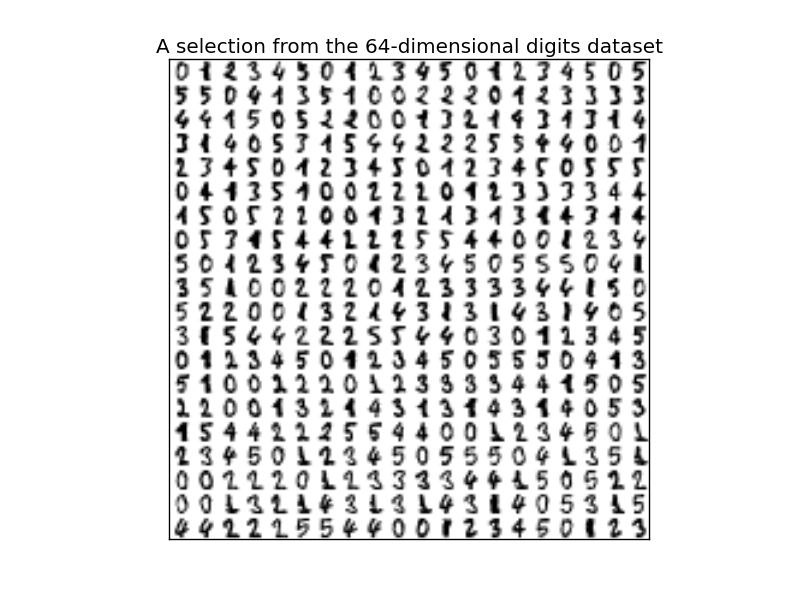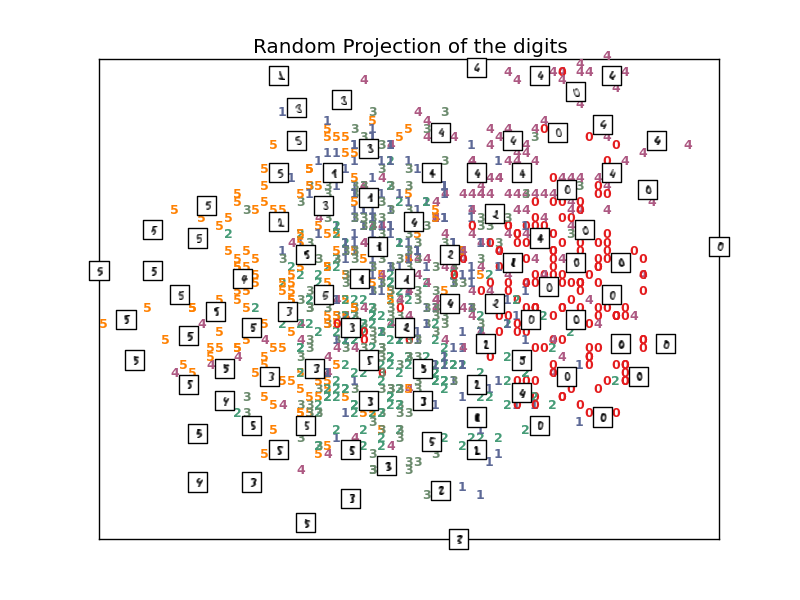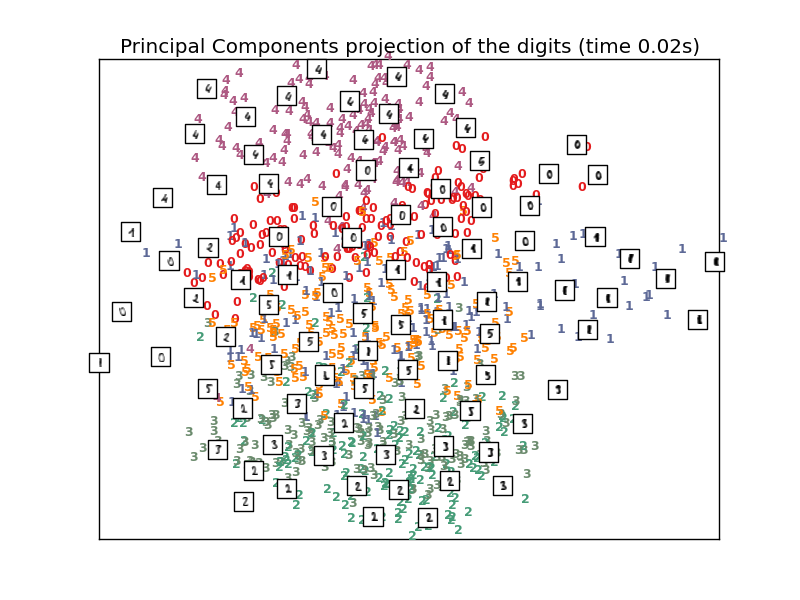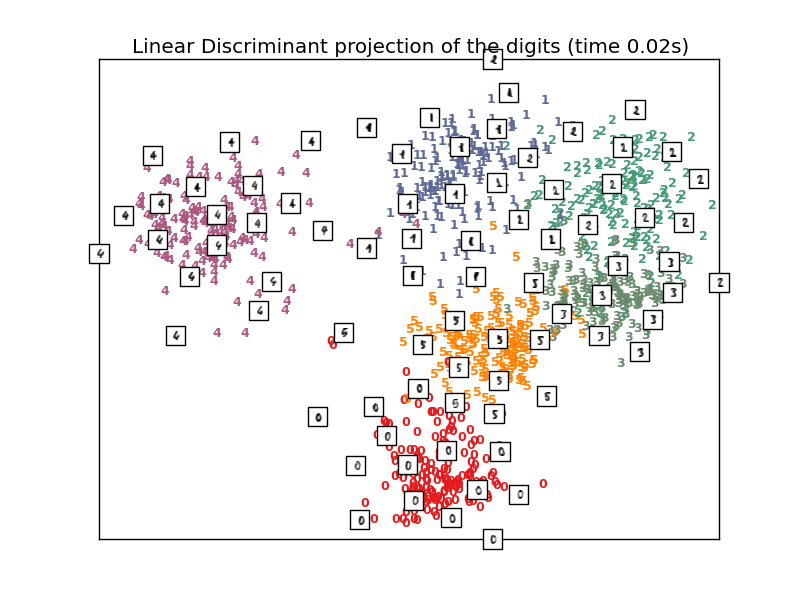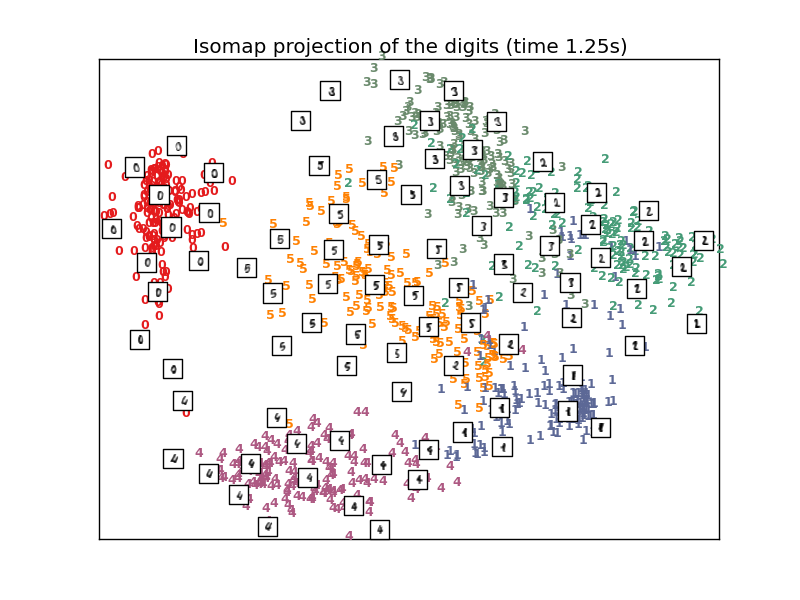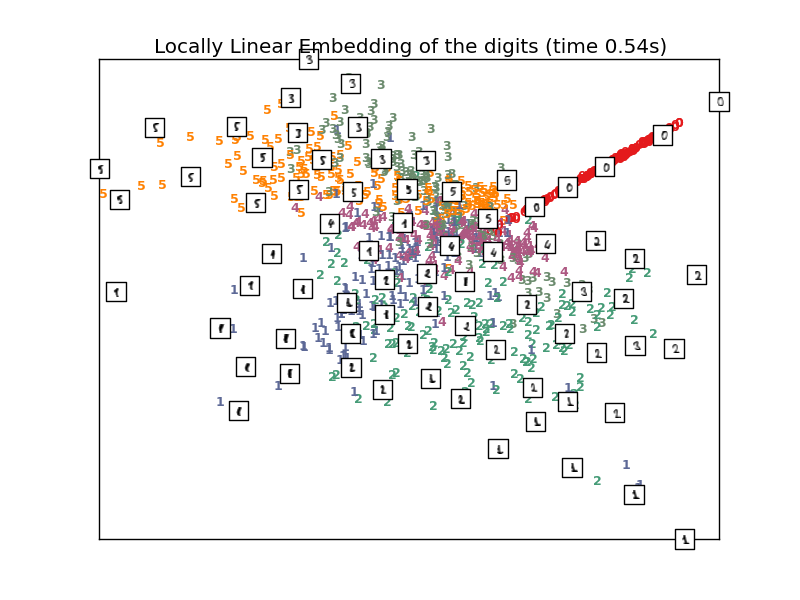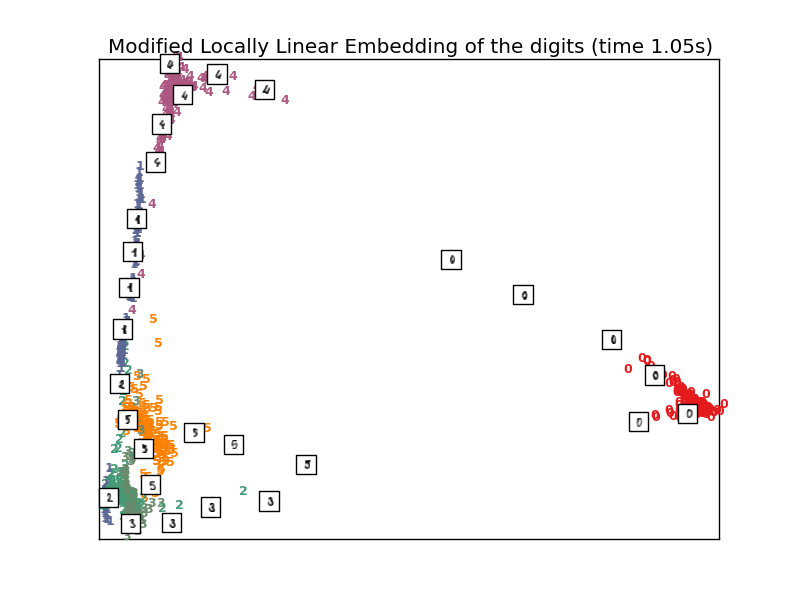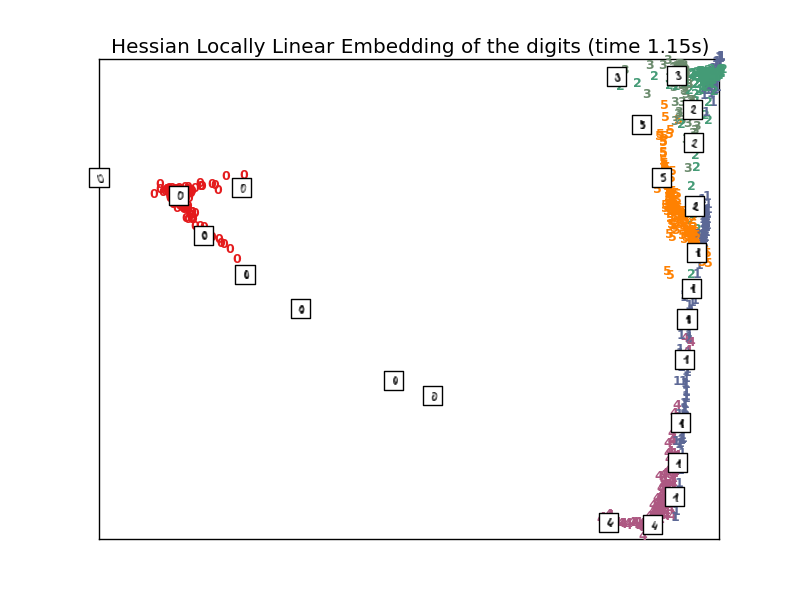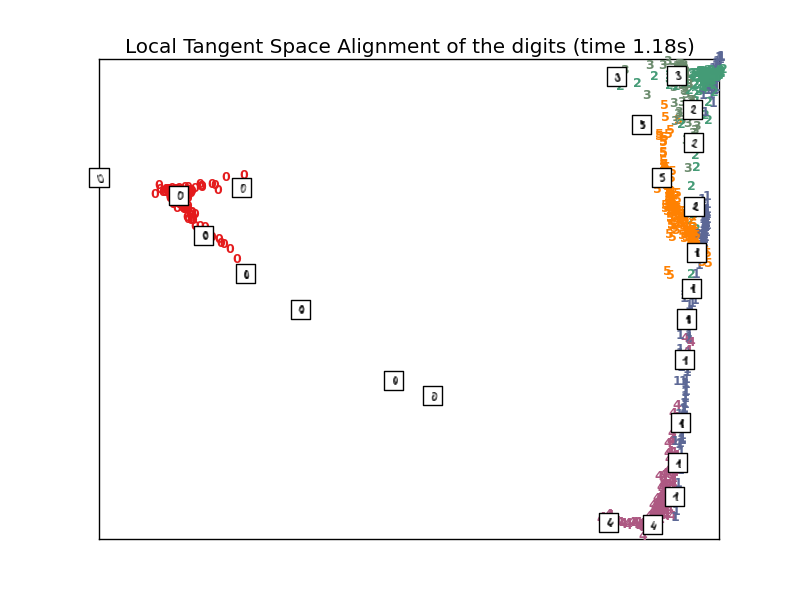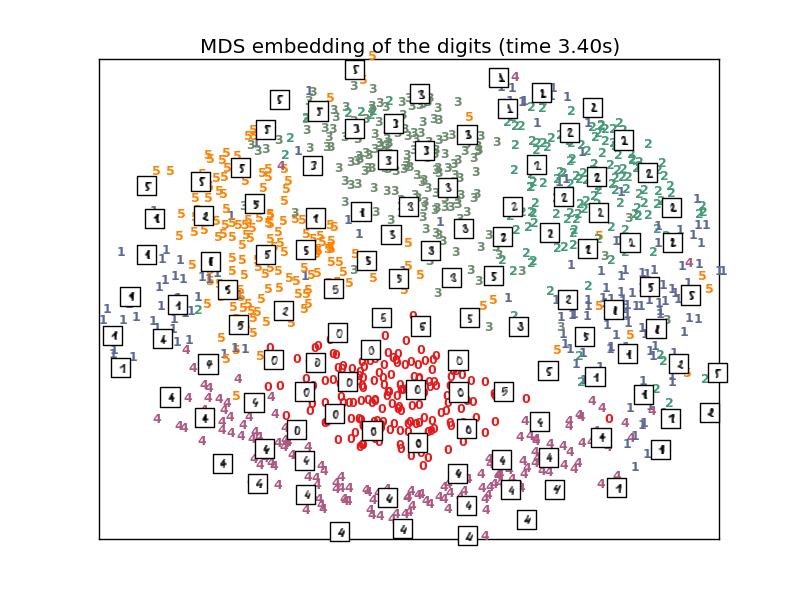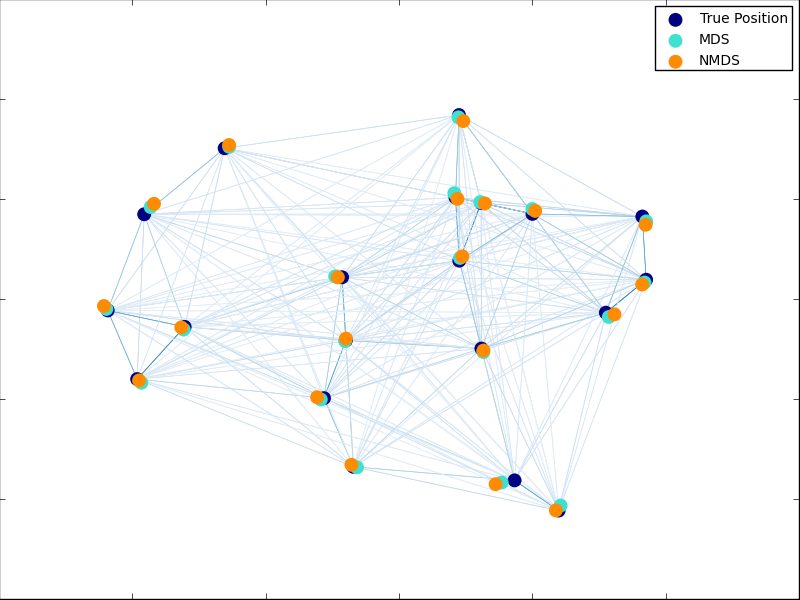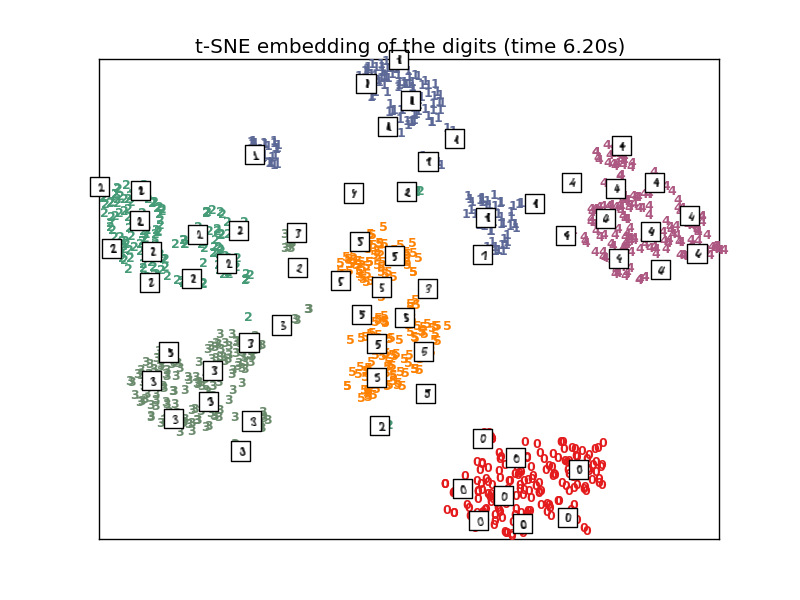2.2. Manifold learning¶
Manifold learning is an approach to non-linear dimensionality reduction. Algorithms for this task are based on the idea that the dimensionality of many data sets is only artificially high.
2.2.1. Introduction¶
High-dimensional datasets can be very difficult to visualize. While data in two or three dimensions can be plotted to show the inherent structure of the data, equivalent high-dimensional plots are much less intuitive. To aid visualization of the structure of a dataset, the dimension must be reduced in some way.
The simplest way to accomplish this dimensionality reduction is by taking a random projection of the data. Though this allows some degree of visualization of the data structure, the randomness of the choice leaves much to be desired. In a random projection, it is likely that the more interesting structure within the data will be lost.
To address this concern, a number of supervised and unsupervised linear dimensionality reduction frameworks have been designed, such as Principal Component Analysis (PCA), Independent Component Analysis, Linear Discriminant Analysis, and others. These algorithms define specific rubrics to choose an “interesting” linear projection of the data. These methods can be powerful, but often miss important non-linear structure in the data.
Manifold Learning can be thought of as an attempt to generalize linear frameworks like PCA to be sensitive to non-linear structure in data. Though supervised variants exist, the typical manifold learning problem is unsupervised: it learns the high-dimensional structure of the data from the data itself, without the use of predetermined classifications.
Examples:
- See Manifold learning on handwritten digits: Locally Linear Embedding, Isomap... for an example of dimensionality reduction on handwritten digits.
- See Comparison of Manifold Learning methods for an example of dimensionality reduction on a toy “S-curve” dataset.
The manifold learning implementations available in sklearn are summarized below
2.2.2. Isomap¶
One of the earliest approaches to manifold learning is the Isomap algorithm, short for Isometric Mapping. Isomap can be viewed as an extension of Multi-dimensional Scaling (MDS) or Kernel PCA. Isomap seeks a lower-dimensional embedding which maintains geodesic distances between all points. Isomap can be performed with the object Isomap.
2.2.2.1. Complexity¶
The Isomap algorithm comprises three stages:
- Nearest neighbor search. Isomap uses
sklearn.neighbors.BallTree for efficient neighbor search.
The cost is approximately
![O[D \log(k) N \log(N)]](../_images/math/fe970e16ff695918dee492901a03d3d94e3d3573.png) , for
, for  nearest neighbors of
nearest neighbors of  points in
points in  dimensions.
dimensions. - Shortest-path graph search. The most efficient known algorithms
for this are Dijkstra’s Algorithm, which is approximately
![O[N^2(k + \log(N))]](../_images/math/7a77f92898506ef618b9aaad553cc8d0644d584a.png) , or the Floyd-Warshall algorithm, which
is
, or the Floyd-Warshall algorithm, which
is ![O[N^3]](../_images/math/b1e15f42370b4dc4c04adc704aa520e0fe45dea8.png) . The algorithm can be selected by the user with
the path_method keyword of Isomap. If unspecified, the code
attempts to choose the best algorithm for the input data.
. The algorithm can be selected by the user with
the path_method keyword of Isomap. If unspecified, the code
attempts to choose the best algorithm for the input data. - Partial eigenvalue decomposition. The embedding is encoded in the
eigenvectors corresponding to the
 largest eigenvalues of the
largest eigenvalues of the
 isomap kernel. For a dense solver, the cost is
approximately
isomap kernel. For a dense solver, the cost is
approximately ![O[d N^2]](../_images/math/ecaf3ef86f6fd84b69074f272980febf7c6148ae.png) . This cost can often be improved using
the ARPACK solver. The eigensolver can be specified by the user
with the path_method keyword of Isomap. If unspecified, the
code attempts to choose the best algorithm for the input data.
. This cost can often be improved using
the ARPACK solver. The eigensolver can be specified by the user
with the path_method keyword of Isomap. If unspecified, the
code attempts to choose the best algorithm for the input data.
The overall complexity of Isomap is
![O[D \log(k) N \log(N)] + O[N^2(k + \log(N))] + O[d N^2]](../_images/math/fd50496ee4e6ec416aa56ab293a06437daeb350f.png) .
.
 : number of training data points
: number of training data points : input dimension
: input dimension : number of nearest neighbors
: number of nearest neighbors : output dimension
: output dimension
References:
- “A global geometric framework for nonlinear dimensionality reduction” Tenenbaum, J.B.; De Silva, V.; & Langford, J.C. Science 290 (5500)
2.2.3. Locally Linear Embedding¶
Locally linear embedding (LLE) seeks a lower-dimensional projection of the data which preserves distances within local neighborhoods. It can be thought of as a series of local Principal Component Analyses which are globally compared to find the best non-linear embedding.
Locally linear embedding can be performed with function locally_linear_embedding or its object-oriented counterpart LocallyLinearEmbedding.
2.2.3.1. Complexity¶
The standard LLE algorithm comprises three stages:
- Nearest Neighbors Search. See discussion under Isomap above.
- Weight Matrix Construction.
![O[D N k^3]](../_images/math/a00fe53bef8884ef1e4612c48f7fb3f6f6134b73.png) .
The construction of the LLE weight matrix involves the solution of a
.
The construction of the LLE weight matrix involves the solution of a
 linear equation for each of the
linear equation for each of the  local
neighborhoods
local
neighborhoods - Partial Eigenvalue Decomposition. See discussion under Isomap above.
The overall complexity of standard LLE is
![O[D \log(k) N \log(N)] + O[D N k^3] + O[d N^2]](../_images/math/ff9da5d2add368dd1270ed207ae10e8ca80b4620.png) .
.
 : number of training data points
: number of training data points : input dimension
: input dimension : number of nearest neighbors
: number of nearest neighbors : output dimension
: output dimension
References:
- “Nonlinear dimensionality reduction by locally linear embedding” Roweis, S. & Saul, L. Science 290:2323 (2000)
2.2.4. Modified Locally Linear Embedding¶
One well-known issue with LLE is the regularization problem. When the number
of neighbors is greater than the number of input dimensions, the matrix
defining each local neighborhood is rank-deficient. To address this, standard
LLE applies an arbitrary regularization parameter  , which is chosen
relative to the trace of the local weight matrix. Though it can be shown
formally that as
, which is chosen
relative to the trace of the local weight matrix. Though it can be shown
formally that as  , the solution converges to the desired
embedding, there is no guarantee that the optimal solution will be found
for
, the solution converges to the desired
embedding, there is no guarantee that the optimal solution will be found
for  . This problem manifests itself in embeddings which distort
the underlying geometry of the manifold.
. This problem manifests itself in embeddings which distort
the underlying geometry of the manifold.
One method to address the regularization problem is to use multiple weight vectors in each neighborhood. This is the essence of modified locally linear embedding (MLLE). MLLE can be performed with function locally_linear_embedding or its object-oriented counterpart LocallyLinearEmbedding, with the keyword method = 'modified'. It requires n_neighbors > n_components.
2.2.4.1. Complexity¶
The MLLE algorithm comprises three stages:
- Nearest Neighbors Search. Same as standard LLE
- Weight Matrix Construction. Approximately
![O[D N k^3] + O[N (k-D) k^2]](../_images/math/29e54135d63cd3804df6986c91488360f24008fd.png) . The first term is exactly equivalent
to that of standard LLE. The second term has to do with constructing the
weight matrix from multiple weights. In practice, the added cost of
constructing the MLLE weight matrix is relatively small compared to the
cost of steps 1 and 3.
. The first term is exactly equivalent
to that of standard LLE. The second term has to do with constructing the
weight matrix from multiple weights. In practice, the added cost of
constructing the MLLE weight matrix is relatively small compared to the
cost of steps 1 and 3. - Partial Eigenvalue Decomposition. Same as standard LLE
The overall complexity of MLLE is
![O[D \log(k) N \log(N)] + O[D N k^3] + O[N (k-D) k^2] + O[d N^2]](../_images/math/12934fe0b6fd78ffdbf076ed359cc8fb9a103848.png) .
.
 : number of training data points
: number of training data points : input dimension
: input dimension : number of nearest neighbors
: number of nearest neighbors : output dimension
: output dimension
References:
- “MLLE: Modified Locally Linear Embedding Using Multiple Weights” Zhang, Z. & Wang, J.
2.2.5. Hessian Eigenmapping¶
Hessian Eigenmapping (also known as Hessian-based LLE: HLLE) is another method of solving the regularization problem of LLE. It revolves around a hessian-based quadratic form at each neighborhood which is used to recover the locally linear structure. Though other implementations note its poor scaling with data size, sklearn implements some algorithmic improvements which make its cost comparable to that of other LLE variants for small output dimension. HLLE can be performed with function locally_linear_embedding or its object-oriented counterpart LocallyLinearEmbedding, with the keyword method = 'hessian'. It requires n_neighbors > n_components * (n_components + 3) / 2.
2.2.5.1. Complexity¶
The HLLE algorithm comprises three stages:
- Nearest Neighbors Search. Same as standard LLE
- Weight Matrix Construction. Approximately
![O[D N k^3] + O[N d^6]](../_images/math/5456e49de4bec0eee990f7c9b98afcd14f68aad1.png) . The first term reflects a similar
cost to that of standard LLE. The second term comes from a QR
decomposition of the local hessian estimator.
. The first term reflects a similar
cost to that of standard LLE. The second term comes from a QR
decomposition of the local hessian estimator. - Partial Eigenvalue Decomposition. Same as standard LLE
The overall complexity of standard HLLE is
![O[D \log(k) N \log(N)] + O[D N k^3] + O[N d^6] + O[d N^2]](../_images/math/845e2e1ea01544e0d335c7b2d48981e335cba4e1.png) .
.
 : number of training data points
: number of training data points : input dimension
: input dimension : number of nearest neighbors
: number of nearest neighbors : output dimension
: output dimension
References:
- “Hessian Eigenmaps: Locally linear embedding techniques for high-dimensional data” Donoho, D. & Grimes, C. Proc Natl Acad Sci USA. 100:5591 (2003)
2.2.6. Spectral Embedding¶
Spectral Embedding (also known as Laplacian Eigenmaps) is one method to calculate non-linear embedding. It finds a low dimensional representation of the data using a spectral decomposition of the graph Laplacian. The graph generated can be considered as a discrete approximation of the low dimensional manifold in the high dimensional space. Minimization of a cost function based on the graph ensures that points close to each other on the manifold are mapped close to each other in the low dimensional space, preserving local distances. Spectral embedding can be performed with the function spectral_embedding or its object-oriented counterpart SpectralEmbedding.
2.2.6.1. Complexity¶
The Spectral Embedding algorithm comprises three stages:
- Weighted Graph Construction. Transform the raw input data into graph representation using affinity (adjacency) matrix representation.
- Graph Laplacian Construction. unnormalized Graph Laplacian
is constructed as
 for and normalized one as
for and normalized one as
 .
. - Partial Eigenvalue Decomposition. Eigenvalue decomposition is done on graph Laplacian
The overall complexity of spectral embedding is
![O[D \log(k) N \log(N)] + O[D N k^3] + O[d N^2]](../_images/math/ff9da5d2add368dd1270ed207ae10e8ca80b4620.png) .
.
 : number of training data points
: number of training data points : input dimension
: input dimension : number of nearest neighbors
: number of nearest neighbors : output dimension
: output dimension
References:
- “Laplacian Eigenmaps for Dimensionality Reduction and Data Representation” M. Belkin, P. Niyogi, Neural Computation, June 2003; 15 (6):1373-1396
2.2.7. Local Tangent Space Alignment¶
Though not technically a variant of LLE, Local tangent space alignment (LTSA) is algorithmically similar enough to LLE that it can be put in this category. Rather than focusing on preserving neighborhood distances as in LLE, LTSA seeks to characterize the local geometry at each neighborhood via its tangent space, and performs a global optimization to align these local tangent spaces to learn the embedding. LTSA can be performed with function locally_linear_embedding or its object-oriented counterpart LocallyLinearEmbedding, with the keyword method = 'ltsa'.
2.2.7.1. Complexity¶
The LTSA algorithm comprises three stages:
- Nearest Neighbors Search. Same as standard LLE
- Weight Matrix Construction. Approximately
![O[D N k^3] + O[k^2 d]](../_images/math/53b01f9fa2117421f78360d9411c0944e9dc643b.png) . The first term reflects a similar
cost to that of standard LLE.
. The first term reflects a similar
cost to that of standard LLE. - Partial Eigenvalue Decomposition. Same as standard LLE
The overall complexity of standard LTSA is
![O[D \log(k) N \log(N)] + O[D N k^3] + O[k^2 d] + O[d N^2]](../_images/math/862543c637da17a6638dcc8fba6ba3eba91e19e9.png) .
.
 : number of training data points
: number of training data points : input dimension
: input dimension : number of nearest neighbors
: number of nearest neighbors : output dimension
: output dimension
References:
- “Principal manifolds and nonlinear dimensionality reduction via tangent space alignment” Zhang, Z. & Zha, H. Journal of Shanghai Univ. 8:406 (2004)
2.2.8. Multi-dimensional Scaling (MDS)¶
Multidimensional scaling (MDS) seeks a low-dimensional representation of the data in which the distances respect well the distances in the original high-dimensional space.
In general, is a technique used for analyzing similarity or dissimilarity data. MDS attempts to model similarity or dissimilarity data as distances in a geometric spaces. The data can be ratings of similarity between objects, interaction frequencies of molecules, or trade indices between countries.
There exists two types of MDS algorithm: metric and non metric. In the scikit-learn, the class MDS implements both. In Metric MDS, the input similarity matrix arises from a metric (and thus respects the triangular inequality), the distances between output two points are then set to be as close as possible to the similarity or dissimilarity data. In the non-metric version, the algorithms will try to preserve the order of the distances, and hence seek for a monotonic relationship between the distances in the embedded space and the similarities/dissimilarities.
Let  be the similarity matrix, and
be the similarity matrix, and  the coordinates of the
the coordinates of the
 input points. Disparities
input points. Disparities  are transformation of
the similarities chosen in some optimal ways. The objective, called the
stress, is then defined by
are transformation of
the similarities chosen in some optimal ways. The objective, called the
stress, is then defined by 
2.2.8.1. Metric MDS¶
The simplest metric MDS model, called absolute MDS, disparities are defined by
 . With absolute MDS, the value
. With absolute MDS, the value  should then correspond exactly to the distance between point
should then correspond exactly to the distance between point  and
and
 in the embedding point.
in the embedding point.
Most commonly, disparities are set to  .
.
2.2.8.2. Nonmetric MDS¶
Non metric MDS focuses on the ordination of the data. If
 , then the embedding should enforce
, then the embedding should enforce  . A simple algorithm to enforce that is to use a monotonic regression
of
. A simple algorithm to enforce that is to use a monotonic regression
of  on
on  , yielding disparities
, yielding disparities  in the same order as
in the same order as  .
.
A trivial solution to this problem is to set all the points on the origin. In
order to avoid that, the disparities  are normalized.
are normalized.
References:
- “Modern Multidimensional Scaling - Theory and Applications” Borg, I.; Groenen P. Springer Series in Statistics (1997)
- “Nonmetric multidimensional scaling: a numerical method” Kruskal, J. Psychometrika, 29 (1964)
- “Multidimensional scaling by optimizing goodness of fit to a nonmetric hypothesis” Kruskal, J. Psychometrika, 29, (1964)
2.2.9. t-distributed Stochastic Neighbor Embedding (t-SNE)¶
t-SNE (TSNE) converts affinities of data points to probabilities. The affinities in the original space are represented by Gaussian joint probabilities and the affinities in the embedded space are represented by Student’s t-distributions. This allows t-SNE to be particularly sensitive to local structure and has a few other advantages over existing techniques:
- Revealing the structure at many scales on a single map
- Revealing data that lie in multiple, different, manifolds or clusters
- Reducing the tendency to crowd points together at the center
While Isomap, LLE and variants are best suited to unfold a single continuous low dimensional manifold, t-SNE will focus on the local structure of the data and will tend to extract clustered local groups of samples as highlighted on the S-curve example. This ability to group samples based on the local structure might be beneficial to visually disentangle a dataset that comprises several manifolds at once as is the case in the digits dataset.
The Kullback-Leibler (KL) divergence of the joint probabilities in the original space and the embedded space will be minimized by gradient descent. Note that the KL divergence is not convex, i.e. multiple restarts with different initializations will end up in local minima of the KL divergence. Hence, it is sometimes useful to try different seeds and select the embedding with the lowest KL divergence.
The disadvantages to using t-SNE are roughly:
- t-SNE is computationally expensive, and can take several hours on million-sample datasets where PCA will finish in seconds or minutes
- The Barnes-Hut t-SNE method is limited to two or three dimensional embeddings.
- The algorithm is stochastic and multiple restarts with different seeds can yield different embeddings. However, it is perfectly legitimate to pick the the embedding with the least error.
- Global structure is not explicitly preserved. This is problem is mitigated by initializing points with PCA (using init=’pca’).
2.2.9.1. Optimizing t-SNE¶
The main purpose of t-SNE is visualization of high-dimensional data. Hence, it works best when the data will be embedded on two or three dimensions.
Optimizing the KL divergence can be a little bit tricky sometimes. There are five parameters that control the optimization of t-SNE and therefore possibly the quality of the resulting embedding:
- perplexity
- early exaggeration factor
- learning rate
- maximum number of iterations
- angle (not used in the exact method)
The perplexity is defined as  where
where  is the Shannon
entropy of the conditional probability distribution. The perplexity of a
is the Shannon
entropy of the conditional probability distribution. The perplexity of a
 -sided die is
-sided die is  , so that
, so that  is effectively the number of
nearest neighbors t-SNE considers when generating the conditional probabilities.
Larger perplexities lead to more nearest neighbors and less sensitive to small
structure. Larger datasets tend to require larger perplexities.
The maximum number of iterations is usually high enough and does not need
any tuning. The optimization consists of two phases: the early exaggeration
phase and the final optimization. During early exaggeration the joint
probabilities in the original space will be artificially increased by
multiplication with a given factor. Larger factors result in larger gaps
between natural clusters in the data. If the factor is too high, the KL
divergence could increase during this phase. Usually it does not have to be
tuned. A critical parameter is the learning rate. If it is too low gradient
descent will get stuck in a bad local minimum. If it is too high the KL
divergence will increase during optimization. More tips can be found in
Laurens van der Maaten’s FAQ (see references). The last parameter, angle,
is a tradeoff between performance and accuracy. Larger angles imply that we
can approximate larger regions by a single point,leading to better speed
but less accurate results.
is effectively the number of
nearest neighbors t-SNE considers when generating the conditional probabilities.
Larger perplexities lead to more nearest neighbors and less sensitive to small
structure. Larger datasets tend to require larger perplexities.
The maximum number of iterations is usually high enough and does not need
any tuning. The optimization consists of two phases: the early exaggeration
phase and the final optimization. During early exaggeration the joint
probabilities in the original space will be artificially increased by
multiplication with a given factor. Larger factors result in larger gaps
between natural clusters in the data. If the factor is too high, the KL
divergence could increase during this phase. Usually it does not have to be
tuned. A critical parameter is the learning rate. If it is too low gradient
descent will get stuck in a bad local minimum. If it is too high the KL
divergence will increase during optimization. More tips can be found in
Laurens van der Maaten’s FAQ (see references). The last parameter, angle,
is a tradeoff between performance and accuracy. Larger angles imply that we
can approximate larger regions by a single point,leading to better speed
but less accurate results.
2.2.9.2. Barnes-Hut t-SNE¶
The Barnes-Hut t-SNE that has been implemented here is usually much slower than
other manifold learning algorithms. The optimization is quite difficult
and the computation of the gradient is ![O[d N log(N)]](../_images/math/8d3d9b0fdf133e7b94e03fd7379e9276974bf9bc.png) , where
, where  is the number of output dimensions and
is the number of output dimensions and  is the number of samples. The
Barnes-Hut method improves on the exact method where t-SNE complexity is
is the number of samples. The
Barnes-Hut method improves on the exact method where t-SNE complexity is
![O[d N^2]](../_images/math/ecaf3ef86f6fd84b69074f272980febf7c6148ae.png) , but has several other notable differences:
, but has several other notable differences:
- The Barnes-Hut implementation only works when the target dimensionality is 3 or less. The 2D case is typical when building visualizations.
- Barnes-Hut only works with dense input data. Sparse data matrices can only be embedded with the exact method or can be approximated by a dense low rank projection for instance using sklearn.decomposition.TruncatedSVD
- Barnes-Hut is an approximation of the exact method. The approximation is parameterized with the angle parameter, therefore the angle parameter is unused when method=”exact”
- Barnes-Hut is significantly more scalable. Barnes-Hut can be used to embed hundred of thousands of data points while the exact method can handle thousands of samples before becoming computationally intractable
For visualization purpose (which is the main use case of t-SNE), using the Barnes-Hut method is strongly recommended. The exact t-SNE method is useful for checking the theoretically properties of the embedding possibly in higher dimensional space but limit to small datasets due to computational constraints.
Also note that the digits labels roughly match the natural grouping found by t-SNE while the linear 2D projection of the PCA model yields a representation where label regions largely overlap. This is a strong clue that this data can be well separated by non linear methods that focus on the local structure (e.g. an SVM with a Gaussian RBF kernel). However, failing to visualize well separated homogeneously labeled groups with t-SNE in 2D does not necessarily implie that the data cannot be correctly classified by a supervised model. It might be the case that 2 dimensions are not enough low to accurately represents the internal structure of the data.
References:
- “Visualizing High-Dimensional Data Using t-SNE” van der Maaten, L.J.P.; Hinton, G. Journal of Machine Learning Research (2008)
- “t-Distributed Stochastic Neighbor Embedding” van der Maaten, L.J.P.
- “Accelerating t-SNE using Tree-Based Algorithms.” L.J.P. van der Maaten. Journal of Machine Learning Research 15(Oct):3221-3245, 2014.
2.2.10. Tips on practical use¶
- Make sure the same scale is used over all features. Because manifold learning methods are based on a nearest-neighbor search, the algorithm may perform poorly otherwise. See StandardScaler for convenient ways of scaling heterogeneous data.
- The reconstruction error computed by each routine can be used to choose
the optimal output dimension. For a
 -dimensional manifold embedded
in a
-dimensional manifold embedded
in a  -dimensional parameter space, the reconstruction error will
decrease as n_components is increased until n_components == d.
-dimensional parameter space, the reconstruction error will
decrease as n_components is increased until n_components == d. - Note that noisy data can “short-circuit” the manifold, in essence acting as a bridge between parts of the manifold that would otherwise be well-separated. Manifold learning on noisy and/or incomplete data is an active area of research.
- Certain input configurations can lead to singular weight matrices, for example when more than two points in the dataset are identical, or when the data is split into disjointed groups. In this case, solver='arpack' will fail to find the null space. The easiest way to address this is to use solver='dense' which will work on a singular matrix, though it may be very slow depending on the number of input points. Alternatively, one can attempt to understand the source of the singularity: if it is due to disjoint sets, increasing n_neighbors may help. If it is due to identical points in the dataset, removing these points may help.
See also
Totally Random Trees Embedding can also be useful to derive non-linear representations of feature space, also it does not perform dimensionality reduction.


